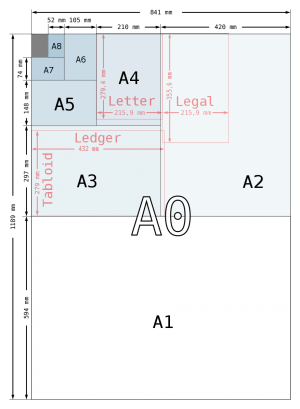Page Sizes: Difference between revisions
No edit summary |
No edit summary |
||
| Line 1: | Line 1: | ||
'''Paper size''' standards of books have varied by country before the implementation of the ISO 216 standard that is the international standard, except in North America and part of Latin America. Since early books were exclusively handmade materials, page sizes varied considerably and without any stand for uniformity. During the manual paper making process, the size of the paper was governed by the size of the framed screen used to hold and mould the paper material solution. <ref | '''Paper size''' standards of books have varied by country before the implementation of the ISO 216 standard that is the international standard, except in North America and part of Latin America. Since early books were exclusively handmade materials, page sizes varied considerably and without any stand for uniformity. During the manual paper making process, the size of the paper was governed by the size of the framed screen used to hold and mould the paper material solution. The 19th century introduced the invention of metal presses, allowed for increased strength of the press and larger pages.<ref> ''Drucker, Johanna. “Chapter 5: The Invention and Spread of Printing.” History of the Book, University of California, Los Angelos. '' </ref> | ||
[[File:877px-A size illustration2 with letter and legal.svg.png|thumb|ISO 216 A series paper sizes with comparison to Letter and Legal. ]] | [[File:877px-A size illustration2 with letter and legal.svg.png|thumb|ISO 216 A series paper sizes with comparison to Letter and Legal. ]] | ||
Revision as of 21:05, 9 December 2020
Paper size standards of books have varied by country before the implementation of the ISO 216 standard that is the international standard, except in North America and part of Latin America. Since early books were exclusively handmade materials, page sizes varied considerably and without any stand for uniformity. During the manual paper making process, the size of the paper was governed by the size of the framed screen used to hold and mould the paper material solution. The 19th century introduced the invention of metal presses, allowed for increased strength of the press and larger pages.[1]

Before ISO 216 Standardization
British Imperial Paper Sizes
Traditional French Paper Sizes
International Standardizations
German physicist, Georg Christoph Lichtenberg appears to be have proposed the standardized paper size system [[1]]
North American Standardizations
References
Bloom, Jonathan. Paper Before Print: the History and Impact of Paper In the Islamic World. E-book, New Haven: Yale University Press, 2001, https://hdl-handle-net.proxy.library.upenn.edu/2027/heb.06496. Accessed 3 Dec 2020.
- ↑ Drucker, Johanna. “Chapter 5: The Invention and Spread of Printing.” History of the Book, University of California, Los Angelos.